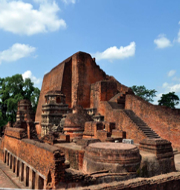Nalanda Mahavihara enters UNESCO's World Heritage Site list
The ruins of ancient Nalanda Mahavihara (also known as old Nalanda University) of Bihar has been included in the List of UNESCO’s World Heritage Site.
Nalanda Mahavihara ruins comprise the archaeological remains of monastic-cum-scholastic from the 5th century BC to the 13th century AD.
It located near Patna, state capital of Bihar and is 26th cultural site of India to get prestigious world heritage status.
Key Facts
- Nalanda Mahavihara was founded by Kumargupta I of the Gupta dynasty in 5th century CE. It was the earliest planned university of the Indian subcontinent.
- It was patronized by various rulers including King Harshavardhana of Kannauj (7th century CE) and the Pala rulers (8th to 12th century CE) as well as various scholars.
- Nalanda was considered as a rare combination of outstanding achievements in institution-building, site-planning, art and architecture.
- It had attracted scholars from the Indian subcontinent and beyond and received patronage of local rulers and foreign kings for period of 800 years.
- Students were admitted in this university after rigorous evaluation only. It imparted knowledge related to Buddhism, contemporary texts and philosophies, logic, grammar, science, and medicine.
- Presently, it is preserved in number of remains of stupas (temple-like structure), shrines and viharas (residential-cum-scholastic structure) and important art works in stucco, stone and metal.
Note: Nalanda University is the second World Heritage site in Bihar after Bodhgaya’s Mahabodhi temple to be accorded UNESCO’s World Heritage Site tag. This status will help in conservation and protection of the site in better way and also increase funds from the UNESCO.
Month: Current Affairs - July, 2016


